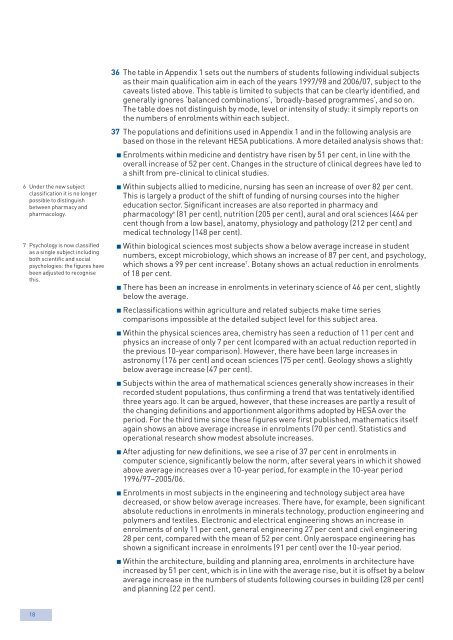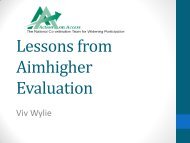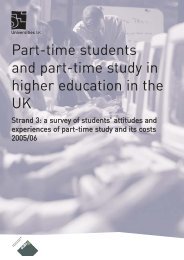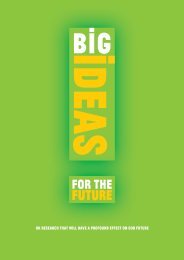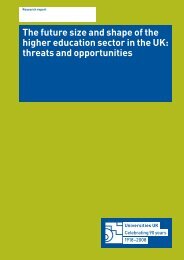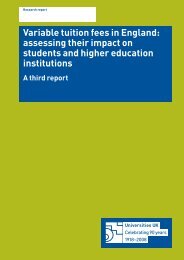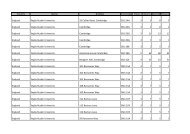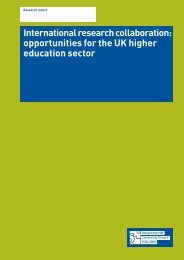Download Document - Universities UK
Download Document - Universities UK
Download Document - Universities UK
Create successful ePaper yourself
Turn your PDF publications into a flip-book with our unique Google optimized e-Paper software.
6 Under the new subjectclassification it is no longerpossible to distinguishbetween pharmacy andpharmacology.7 Psychology is now classifiedas a single subject includingboth scientific and socialpsychologies: the figures havebeen adjusted to recognisethis.36 The table in Appendix 1 sets out the numbers of students following individual subjectsas their main qualification aim in each of the years 1997/98 and 2006/07, subject to thecaveats listed above. This table is limited to subjects that can be clearly identified, andgenerally ignores ‘balanced combinations’, ‘broadly-based programmes’, and so on.The table does not distinguish by mode, level or intensity of study: it simply reports onthe numbers of enrolments within each subject.37 The populations and definitions used in Appendix 1 and in the following analysis arebased on those in the relevant HESA publications. A more detailed analysis shows that:pEnrolments within medicine and dentistry have risen by 51 per cent, in line with theoverall increase of 52 per cent. Changes in the structure of clinical degrees have led toa shift from pre-clinical to clinical studies.pWithin subjects allied to medicine, nursing has seen an increase of over 82 per cent.This is largely a product of the shift of funding of nursing courses into the highereducation sector. Significant increases are also reported in pharmacy andpharmacology 6 (81 per cent), nutrition (205 per cent), aural and oral sciences (464 percent though from a low base), anatomy, physiology and pathology (212 per cent) andmedical technology (148 per cent).pWithin biological sciences most subjects show a below average increase in studentnumbers, except microbiology, which shows an increase of 87 per cent, and psychology,which shows a 99 per cent increase 7 . Botany shows an actual reduction in enrolmentsof 18 per cent.pThere has been an increase in enrolments in veterinary science of 46 per cent, slightlybelow the average.pReclassifications within agriculture and related subjects make time seriescomparisons impossible at the detailed subject level for this subject area.pWithin the physical sciences area, chemistry has seen a reduction of 11 per cent andphysics an increase of only 7 per cent (compared with an actual reduction reported inthe previous 10-year comparison). However, there have been large increases inastronomy (176 per cent) and ocean sciences (75 per cent). Geology shows a slightlybelow average increase (47 per cent).pSubjects within the area of mathematical sciences generally show increases in theirrecorded student populations, thus confirming a trend that was tentatively identifiedthree years ago. It can be argued, however, that these increases are partly a result ofthe changing definitions and apportionment algorithms adopted by HESA over theperiod. For the third time since these figures were first published, mathematics itselfagain shows an above average increase in enrolments (70 per cent). Statistics andoperational research show modest absolute increases.pAfter adjusting for new definitions, we see a rise of 37 per cent in enrolments incomputer science, significantly below the norm, after several years in which it showedabove average increases over a 10-year period, for example in the 10-year period1996/97–2005/06.pEnrolments in most subjects in the engineering and technology subject area havedecreased, or show below average increases. There have, for example, been significantabsolute reductions in enrolments in minerals technology, production engineering andpolymers and textiles. Electronic and electrical engineering shows an increase inenrolments of only 11 per cent, general engineering 27 per cent and civil engineering28 per cent, compared with the mean of 52 per cent. Only aerospace engineering hasshown a significant increase in enrolments (91 per cent) over the 10-year period.pWithin the architecture, building and planning area, enrolments in architecture haveincreased by 51 per cent, which is in line with the average rise, but it is offset by a belowaverage increase in the numbers of students following courses in building (28 per cent)and planning (22 per cent).18


